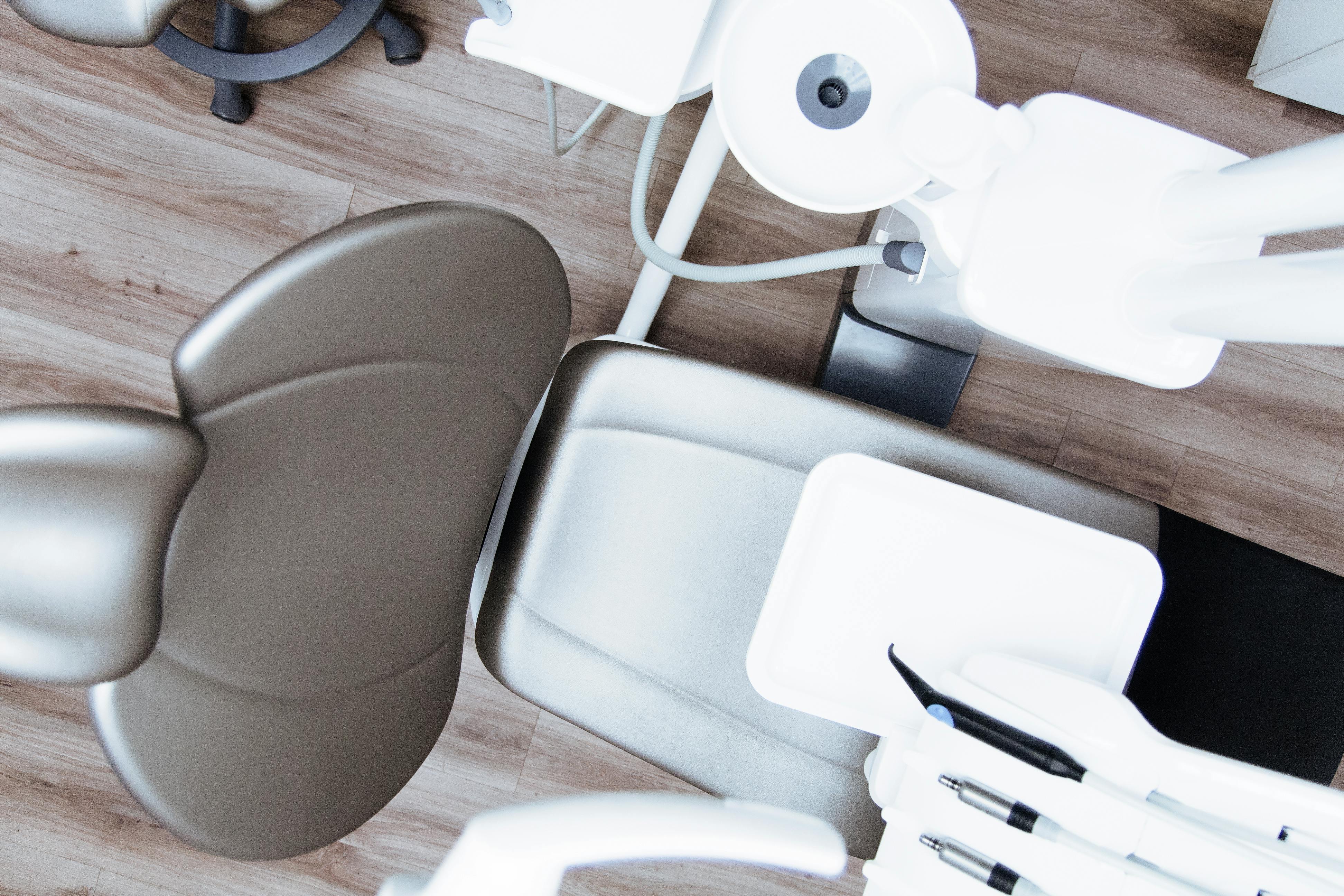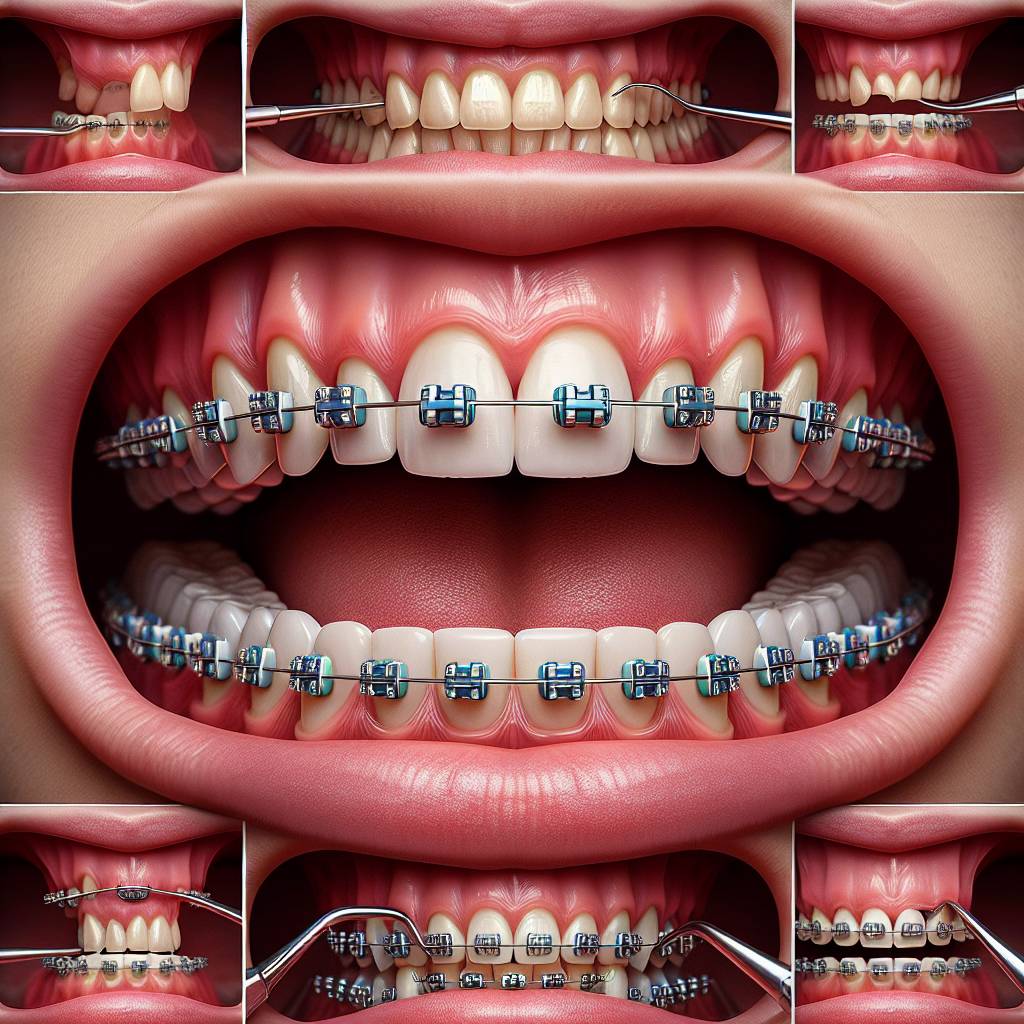Braces are a popular orthodontic treatment for straightening crooked teeth and improving the appearance of your smile. They work by using gentle pressure to slowly move the teeth into their desired positions. The braces consist of brackets that are attached to each tooth, and a wire is threaded through them to hold them in place. The wire is then tightened regularly by the orthodontist in order to gradually move the teeth into their correct position. When the desired result has been achieved, the braces are then removed and a retainer is used to maintain the new position of the teeth.Braces, also known as orthodontic treatment, are devices used to align and straighten teeth and help to improve the overall appearance of teeth. They consist of brackets that are bonded to the teeth and connected by a wire or rubber band. Braces can be used to correct misaligned teeth, overbites, underbites and other dental problems. Treatment time varies depending on the severity of the problem but typically lasts between one and three years.
How Do Braces Work For Crooked Teeth?
Braces are an orthodontic treatment used to straighten crooked teeth. They are composed of brackets, wires, and elastics that work together to gradually move teeth into their proper position. The brackets are bonded to the front of each tooth and connected with a thin metal wire. The wires are then tightened in order to apply pressure on the teeth and move them into alignment. Elastics may also be used to provide additional tension to help guide the teeth into place. Treatment times vary depending on the severity of the misalignment, but typically last between one and three years. During treatment, patients may need periodic visits with their orthodontist in order to adjust the braces and allow for further tooth movement. Once complete, patients will have a beautifully straight smile that will last for years.
Braces can be used to treat a variety of dental problems, such as overcrowding, gaps between teeth, overbites, underbites, crossbites and open bites. By applying pressure to specific areas of the mouth over time, braces can help correct these common problems and give patients a more attractive smile. Braces can also improve oral health by making it easier for patients to properly brush and floss their teeth.
Overall, braces are an effective way to correct crooked teeth and give patients straighter smiles that boost their confidence. If you or your child has misaligned teeth, be sure to talk with your orthodontist about braces as an option for treatment!
Types of Braces
Braces are a great way to straighten teeth and improve your smile. They can be used to treat a wide range of orthodontic issues, from simple crowding to more severe bite problems. There are several types of braces available, each with its own advantages and disadvantages. Here we’ll look at some of the most common types and how they can help you achieve your desired smile.
Metal braces are the most traditional form of braces. They are typically made from stainless steel brackets bonded directly to the teeth. Metal braces use rubber bands or elastic ties to hold the archwire in place and move the teeth into their correct position. They’re usually the least expensive option, but they can also be uncomfortable and not as aesthetically pleasing as other types of braces.
Ceramic braces are similar to metal braces in that they use brackets bonded to the teeth, but instead of stainless steel, they use either clear or tooth-colored ceramic material. This makes them less visible than traditional metal braces, making them a popular choice among adults who don’t want their orthodontic treatment to be too noticeable. Ceramic braces tend to be more expensive than metal ones, but they are still a cost-effective option for many patients.
Lingual braces are an alternative type of orthodontic treatment that is growing in popularity among adults who want a discreet smile correction solution. Lingual braces are similar to traditional metal braces, except that the brackets and wires are attached on the backside of the teeth instead of on the front side. This makes them nearly invisible when you talk or smile, which can be beneficial for those who don’t want others to know that they’re wearing braces.
Invisalign is another popular orthodontic treatment option for adults who wish for a more discreet solution than traditional metal or ceramic braces. Invisalign uses plastic aligners that fit snugly over your teeth like a retainer would do and gradually move your teeth into their proper positions over time without anyone noticing you’re wearing them! Invisalign is usually more expensive than other types of orthodontic treatments, but it’s also one of the most comfortable options available and doesn’t require any dietary restrictions since you can remove it easily when eating or drinking anything other than water.
Ultimately, there is no one-size-fits-all solution when it comes to choosing an orthodontic treatment option; what works best for one patient may not work well for another patient’s needs or lifestyle preferences. The best way to determine which type of brace will give you optimal results is by speaking with your orthodontist about all your options so you can decide which one is right for you!
How Long Does it Take to Straighten Teeth with Braces?
The amount of time it takes to straighten teeth with braces depends on the severity of the misalignment. Generally, mild cases take 6-12 months to correct, while more severe misalignment may take up to 24-36 months. The teeth should begin moving within the first few weeks after treatment starts. The process of straightening teeth can take up to twice as long for adults because their bones and gums have become more rigid and difficult to move.
Orthodontists use a variety of techniques to move teeth into their proper positions. These include brackets, rubber bands, and wires. During treatment, your orthodontist will measure your progress and make adjustments as needed. This helps ensure that your treatment is progressing in the right direction and that your teeth are being moved at an appropriate rate.
In addition to regular check-ups with your orthodontist, you’ll need to maintain good oral hygiene habits while wearing braces in order for them to be effective. Brushing thoroughly after each meal is essential for preventing plaque buildup, which can lead to cavities and gum disease if left untreated. You should also floss at least once a day and use a fluoride mouthwash regularly.
Overall, the amount of time it takes to straighten teeth with braces varies from person to person depending on the severity of their misalignment and how well they follow their orthodontist’s instructions. If you have questions about how long it will take for you or your child’s braces treatment, you should speak with an experienced orthodontist who can provide you with more specific information about your individual case.
Benefits of Braces for Crooked Teeth
Braces are one of the most popular and effective treatments for crooked teeth. They help correct the alignment and positioning of the teeth, resulting in a more aesthetically pleasing smile. Apart from improving your smile, there are many other benefits that come with wearing braces. Here are some of the most important ones:
Improved Oral Health
Straightening your teeth helps reduce the risk of tooth decay and gum disease. Crowded or crooked teeth are difficult to keep clean, making them more prone to plaque buildup and infection. By properly aligning your teeth, braces make it easier to brush and floss properly, which helps protect against these issues.
Reduced Risk of Injury
Misaligned teeth can contribute to an increased risk of injury to the mouth or jaw in the event of a fall or accident. This is because misaligned teeth can affect how your jaw functions, making it more vulnerable to injuries due to uneven pressure on certain parts.
Increased Self-confidence
Having a straight smile can greatly improve your self-confidence and overall quality of life. You may find yourself smiling more often when you don’t have to worry about how your crooked teeth look. Additionally, braces can correct any overbites or underbites you may have, further improving your appearance and boosting your self-esteem.
Improved Speech
Crooked teeth can cause speech impediments such as lisps or whistles when speaking certain sounds. Braces help correct these issues by aligning the teeth and jaws properly so that speech is clearer and more precise. Additionally, some people suffer from TMJ (temporomandibular joint) pain due to misaligned jaws, which can also be corrected with braces.
These are just a few of the many benefits that come with wearing braces for crooked teeth. With proper care and maintenance, you can enjoy straighter, healthier teeth in no time!

Possible Complications of Wearing Braces
Wearing braces can often lead to a number of potential complications, both short and long-term. Some short-term issues that may arise include discomfort and soreness, especially in the first few weeks after wearing the braces. This is due to the pressure exerted on the teeth from the brackets and wires, which can take some time to adjust to. Other common issues include difficulty eating certain foods and increased exposure to cavities due to hard-to-reach areas where food particles may get trapped. In addition, there is also a risk of mouth sores or ulcers forming as a result of the brackets rubbing against the soft tissue inside the mouth.
Long-term problems associated with wearing braces may include permanent damage to the teeth or gums due to incorrect application or excessive pressure exerted by the braces. In some cases, this can lead to enamel erosion or even tooth loss if not treated promptly. It is also possible for teeth to become misaligned once again after treatment if proper care is not taken, such as wearing a retainer as recommended by your orthodontist. Additionally, there is also an increased risk of gum disease due to food particles being trapped around the brackets and wires.
Foods to Avoid When Wearing Braces
Braces can help give you the beautiful, straight smile you’ve always wanted. But if not cared for properly, they can lead to a lot of discomfort and cause damage to your teeth and gums. To ensure that your braces are working properly and to keep them from causing any damage, it’s important to avoid certain foods that may be difficult or impossible to eat with braces.
Some of the foods that should be avoided when wearing braces include hard or crunchy foods like popcorn, chips, nuts, apples, and carrots. Foods with small pieces like granola or trail mix should also be avoided as these can get stuck in the brackets or wires of your braces. Sticky foods like taffy, gummy bears, and licorice are also bad for your braces as they can stick to the wires and brackets, which can cause them to bend or break. Finally, it’s best to avoid sugary snacks like candy and soda as these can lead to tooth decay and cavities.
In addition to avoiding certain foods when wearing braces, it’s important to practice good oral hygiene habits in order to maintain healthy teeth and gums. Be sure to brush after every meal and floss regularly in order keep your teeth clean while wearing braces. If you have any questions about what foods you should avoid when wearing braces, be sure to ask your dentist or orthodontist for more information.
Caring for Your Teeth While Wearing Braces
It is important to take special care of your teeth while wearing braces. Proper oral hygiene habits are a must to ensure that your teeth stay healthy and free from cavities and gum disease. Here are some tips to help you care for your teeth while wearing braces:
Brush your teeth at least twice a day with a fluoride toothpaste. Make sure to brush the areas around the brackets and wires, as this will help remove any plaque and food particles that have collected there. Flossing should also be done every day, being sure to use floss threaders or disposable flossers so that you can get between the wires and brackets.
Use an interdental brush or floss picks to help remove food particles from between the teeth and braces. Change out your toothbrush often, especially when you first get your braces, as the bristles may wear down quickly with all of the extra brushing.
Avoid certain foods that may damage your braces such as hard candy, nuts, popcorn or chewing gum. If you do eat these types of foods, be sure to brush well afterwards to avoid any buildup of plaque on the brackets or wires. You should also avoid sugary snacks or drinks, as these can cause tooth decay if not removed promptly.
See your dentist regularly for check-ups and cleanings while you have braces. This will allow them to properly monitor any changes in your oral health during treatment and make sure that everything is progressing as expected. With proper care and maintenance, you can ensure that your braces stay in good shape while keeping your teeth healthy too!

Conclusion
Braces are an effective way to straighten crooked teeth and achieve a beautiful smile. Braces can be used alone or in combination with other treatments, such as orthodontic surgery and clear aligners, to produce a straighter smile. The amount of time needed to wear braces will depend on the severity of your misalignment, but typically braces need to be worn for at least one year. The periodic adjustments made by your orthodontist are essential for success in achieving the desired results.
Braces also increase the strength and health of your teeth and gums. By ensuring proper alignment of teeth, you can prevent serious dental problems such as cavities, gum disease, and even jaw pain. Additionally, braces can improve your overall self-confidence and quality of life by providing you with a straight smile that you can be proud of.
Overall, braces are an excellent option for those looking to straighten their crooked teeth and achieve a healthier smile. With the right care and maintenance, you can enjoy your new look for many years to come!

